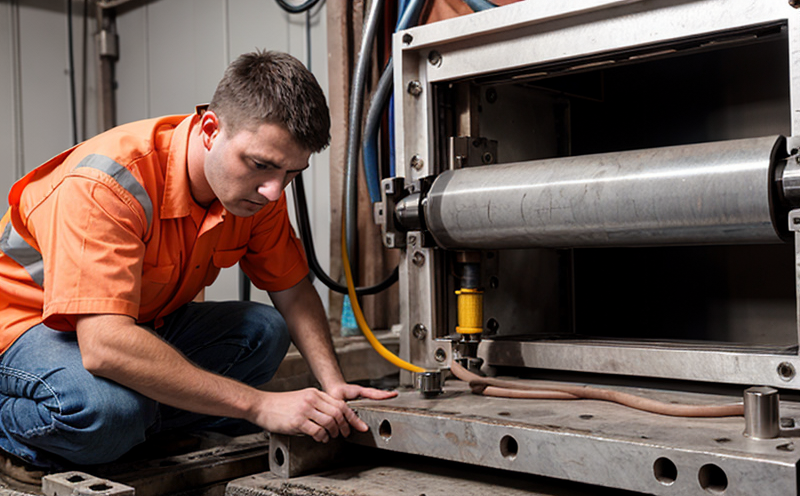EN 50085 Mechanical Impact Testing of Conduits for Lighting Installations
The European Standard EN 50085 specifies procedures to evaluate the mechanical impact resistance of conduits used in lighting installations. This test is crucial for ensuring that conduit systems can withstand typical environmental stresses and accidental impacts without compromising safety or integrity.
EN 50085 applies particularly to rigid metallic conduits, flexible conduits, and their associated fittings used in electrical installations such as those found in commercial buildings, industrial facilities, and public spaces. The standard addresses the mechanical impact testing requirements for these components, focusing on their resistance against impacts from falling objects or similar external forces.
The test procedure outlined in EN 50085 involves subjecting a specimen conduit to various impact tests using standardized weights dropped from different heights. The goal is to determine whether the conduit will sustain damage that could compromise its function and safety when exposed to realistic environmental conditions. Compliance with this standard ensures that lighting installations remain safe, reliable, and functional over their intended lifespan.
For quality managers and compliance officers responsible for ensuring product integrity within these sectors, EN 50085 provides a clear framework for assessing the mechanical robustness of conduit systems. R&D engineers can utilize this standard to develop innovative solutions that meet both performance requirements and regulatory expectations. Additionally, procurement professionals benefit from knowing which suppliers adhere to such rigorous testing protocols.
The test procedure typically involves several stages:
- Preparation of the specimen conduit according to specified dimensions and conditions.
- Application of standardized weights representing potential impact loads.
- Dropping these weights onto the prepared specimen from predetermined heights.
- Evaluation of any resulting damage or deformation based on predefined criteria.
The results of this testing help manufacturers ensure their products meet stringent quality standards, thereby enhancing consumer confidence and regulatory compliance. By adhering to EN 50085, companies demonstrate a commitment to producing robust, reliable conduit systems that contribute significantly to overall installation safety and longevity.
In summary, the EN 50085 mechanical impact testing procedure plays an essential role in safeguarding lighting installations against potential hazards posed by accidental impacts. Its rigorous standards provide peace of mind for all stakeholders involved in designing, manufacturing, installing, and maintaining these systems.
Why Choose This Test
- Ensures compliance with international standards (EN 50085).
- Evaluates mechanical robustness under realistic conditions.
- Enhances consumer confidence in product safety and durability.
- Supports regulatory requirements for lighting installations.
- Aids manufacturers in meeting stringent quality standards.
The EN 50085 test is an essential tool for any organization involved in the production or sale of conduit systems used in lighting installations. By choosing this test, you demonstrate a commitment to excellence and reliability, ensuring that your products meet both current regulatory demands and future industry trends.
Quality and Reliability Assurance
The EN 50085 mechanical impact testing is integral to maintaining high standards of quality and reliability in conduit systems for lighting installations. It provides a rigorous framework that helps manufacturers identify potential weaknesses before they become critical issues during installation or use.
This type of testing ensures that each component undergoes thorough evaluation, guaranteeing consistent performance across all units produced. Quality managers rely on such tests to maintain strict control over manufacturing processes and materials used in production. Compliance with EN 50085 helps avoid costly recalls and repairs while fostering trust among customers.
For R&D engineers, this standard offers valuable insights into how different design variations affect mechanical performance. They can use these findings to refine designs continuously based on real-world test results. Such continuous improvement contributes significantly to the overall advancement of technology within the lighting industry.
Environmental and Sustainability Contributions
The EN 50085 mechanical impact testing plays a pivotal role in promoting environmental sustainability by ensuring longevity and reliability of conduit systems used in lighting installations. Long-lasting products mean less waste generated from frequent replacements, contributing positively to resource conservation efforts.
By adhering to this standard, manufacturers contribute towards reducing energy consumption associated with production processes. Additionally, durable conduit systems reduce the need for frequent maintenance activities, which can otherwise lead to increased carbon footprints due to transportation and labor costs involved in replacement or repair.
The commitment to sustainable practices through rigorous testing also extends beyond individual companies; it influences broader industry trends towards more environmentally friendly manufacturing methods. This collective effort helps create a healthier environment for future generations while maintaining robust economic growth within the lighting sector.





